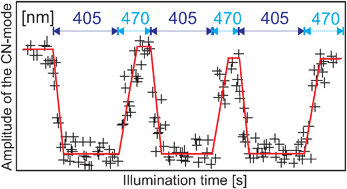Reversible photoisomerization of an azobenzene-functionalized self-assembled monolayer probed by sum-frequency generation vibrational spectroscopy
Abstract
Sum-frequency generation (![[triple bond, length as m-dash]](https://www.rsc.org/images/entities/char_e002.gif) N marker group at the outer
N marker group at the outer

* Corresponding authors
a
Freie Universität Berlin, Fachbereich Physik, Arnimallee 14, D-14195 Berlin, Germany
E-mail:
petra.tegeder@physik.fu-berlin.de
b Technische Universität Berlin, Institut für Chemie, Strasse des 17. Juni 135, D-10623 Berlin, Germany
c Max-Born-Institut, Max-Born-Str. 2A, 12489 Berlin, Germany
d Fritz-Haber-Institut der MPG, Department of Physical Chemistry, Faradayweg 4–6, D-14195 Berlin, Germany
Sum-frequency generation (![[triple bond, length as m-dash]](https://www.rsc.org/images/entities/char_e002.gif) N marker group at the outer
N marker group at the outer

 Please wait while we load your content...
Something went wrong. Try again?
Please wait while we load your content...
Something went wrong. Try again?
S. Wagner, F. Leyssner, C. Kördel, S. Zarwell, R. Schmidt, M. Weinelt, K. Rück-Braun, M. Wolf and P. Tegeder, Phys. Chem. Chem. Phys., 2009, 11, 6242 DOI: 10.1039/B823330F
To request permission to reproduce material from this article, please go to the Copyright Clearance Center request page.
If you are an author contributing to an RSC publication, you do not need to request permission provided correct acknowledgement is given.
If you are the author of this article, you do not need to request permission to reproduce figures and diagrams provided correct acknowledgement is given. If you want to reproduce the whole article in a third-party publication (excluding your thesis/dissertation for which permission is not required) please go to the Copyright Clearance Center request page.
Read more about how to correctly acknowledge RSC content.
 Fetching data from CrossRef.
Fetching data from CrossRef.
This may take some time to load.
Loading related content
